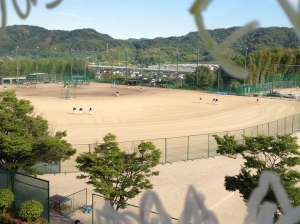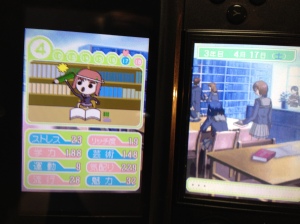As any teacher in Japan will tell you, there’s far more to teaching than actually being in the classroom (actually, this is true for teachers outside of Japan as well). In fact, some of the greatest moments of culture shock can happen during those in-between times, since it’s really difficult to know how to navigate through life outside of the classroom at school. I’ve got a few observations to share, which I’ve divided into four basic categories, so read on and take them for what they’re worth!

1. Life in the Staff Room
For foreign teachers (especially those in the JET Programme) the staff room can easily become something akin to a second home. There are lots of busy times in each semester, but there are definitely slow times as well, and ALTs are expected to be at school for the full workday regardless of whether or not there’s any actual work to do. I have spent countless hours staving off boredom by studying Japanese or reading books at my desk. That’s a little strange to me, because generally in Canada it’s highly frowned upon for employees not to be busy during paid work hours.
Even more surprising is the fact that Japanese teachers can often be seen sleeping at their desks. In fact, at my school there is a designated tatami room just off of the main staff room wherein teachers can grab a quick nap if they’re tired. In Canada, sleeping at work would likely get someone fired.
Of course, that isn’t to say Japanese teachers don’t have anything to do, or that they’re lazy—if anything, the fact that so many need to sleep at work probably suggests that they’re overworked. I think it just shows a major cultural difference. One time one of my coworkers was talking about how people in America don’t work much overtime, and she said, “Japanese teachers have so much work to do!” The implication seemed to be that Americans are lazy or just unwilling to work. It seems to me that Americans have a lot of work to do as well, but they’re expected to do it all in an eight-hour period without taking naps. I think in America people are more insistent about being paid for their overtime, so employers crack the whip a little more in regard to how they spend that eight-hour period in an attempt to avoid paying the overtime. In Japan teachers are generally expected to work overtime without extra pay, so how they spend their ten or twelve hours at work is policed a little less.
Because teachers spend so much time at work, the staff room can also become a little more intimate than teachers’ rooms in Canada would. For example, in Canada I never saw people cutting their nails or shaving right in the staff room at any job. But again, with so much time spent at work, when else are people going to get these things done?
There’s definitely one area of staff room life that I love, and that’s the communal food sharing. Here in Japan whenever somebody travels he or she will usually bring back “omiyage”, or snacks from their travel destination, for coworkers to enjoy. So every once in a while I’ll find a box of sweets from Hiroshima or Tokyo on the counter in the little staff kitchen.

It’s great. You can sample all the tastes of Japan from that one staff kitchen, depending on how often your coworkers travel! And, of course, it makes you want to bring something back for them when you find time to get away.
Often the snacks in the staff room have nothing to do with travel, though (at least at my school). A lot of times teachers will just bring sweets or crackers in to share them with everyone—sometimes there are nashi (a fruit that’s something like a mix between an apple and a pear) or mikan (Japanese oranges). A few weeks ago the school groundskeeper brought in a bunch of eggplant for everyone to take home, so I was able to try making baba ganouj for the first time. It’s a great way for everyone to show appreciation for each other and just to brighten up each other’s day a bit.
2. Ceremonies, Assemblies, and School Festivals
Ceremonies, assemblies, and school festivals can, depending on your level of shyness and/or Japanese language skills, be the most fun or the most awkward parts of school life in Japan. They’re fun because they’re a break from classes and often a good chance to get to know the students and teachers at your school(s). They’re awkward because they’re pretty much entirely in Japanese and without a translator you can sometimes feel left in the dust.
In my opinion ceremonies are by far the most awkward and painful part of teaching in Japanese schools. That’s primarily because they consist of multiple speeches, all of which are in Japanese, and usually last about an hour. They’re also somewhat frequent, particularly in the spring. March and April can feel like you’re dying of ceremony overload, because there are graduation ceremonies, leaving ceremonies for the leaving teachers (more on that later), welcoming ceremonies for the new teachers, entrance ceremonies…it’s brutal.
Ceremonies generally are pretty solemn events, especially graduations. That takes some getting used to as a Canadian, because graduations where I come from are usually celebrations. There are a lot of people cheering and laughing and smiling and hugging. In Japan, though, it’s completely the opposite. In fact, last year as we were heading to the gym for the graduation ceremony one of the teachers said to me, “graduations are very serious here. So no smiling.” I still have no idea whether he was kidding or not. There’s a great video about ceremonies in Japanese schools that you can check out on YouTube if you want to prepare yourself for the ceremony onslaught.
Assemblies can be painful too, because they last a long time (about an hour or two) and are usually in Japanese, but foreign teachers often get to miss them. At my school the Japanese teachers don’t even bother telling the foreign teachers that an assembly is going to happen, because an hour-long lecture on not drinking and driving all in Japanese isn’t going to do us much good. Actually, a lot of the time there are a few teachers that skip out as well, so I get the feeling that assemblies are a lot more laid-back than the ceremonies.
Festivals, on the other hand, are kind of double-edged swords. They’re awkward because the students put weeks, sometimes months, into planning them, and English is usually not a top priority for them. For a foreign teacher, this can mean a lot of standing around, trying not to get in the way. Maybe I should explain what the festivals are, though. Basically, once a year every high school and junior high school has a “sports day”, something I dreaded before actually experiencing it. I thought it would be a full day of baseball and soccer games in the sweltering mid-September heat, but it’s actually more like a day of sports-inspired games. At my school there are a lot of obstacle races, tug-of-wars, and team jump rope competitions. It’s kind of fun to watch, but it also makes me thank my lucky stars that I was never a Japanese high school student because it’s a full school day of physical exertion. The students spend a lot of time sitting under tarps in the hot dirt of the sports field. (I’ve never seen a school here with grass in the sports fields. I think the students play too hard for it to be possible to maintain.)

After the sports festival there are two days of culture festivals. These are largely run by the students, and are an opportunity for them to showcase their club activities and skills to other students. At my school the drama club always puts on a play, the brass band club plays some songs, the English club introduces the ALTs and foreign exchange students, and there’s always some kind of funny dramatic performance put on by the students with teachers cast in ridiculous roles. Last year it was kind of difficult to endure, because my Japanese language skills were so poor that I never had any idea what was going on. This year it was a lot easier, and I enjoyed myself much more. Last year I also had to give a self-introduction in front of the whole school and talk about Canada during the English club’s presentation, but this year the students already know me and we had a new ALT joining the staff, so I was off the hook.
The second day of the culture festival is a bit freer and is, in my opinion, the most fun. The school is open to public, so everyone can come and see what’s going on at the local high schools (and maybe the junior high schools too, but I’m not sure). The students set up food stands and sell snow cones, French fries, okonomiyaki, yakisoba, or anything else they think will appeal to people. Some of the clubs will display their work—the tea ceremony club, for example, will have an open ceremony that anyone can attend, and the flower arranging club puts their work out for everyone to see. Last year for a hundred yen (about a dollar) I even got to make my own little flower arrangement:

The students also set up games in their classrooms, like ring tosses and trivia, and they give out candy or little prizes for winners. It’s a lot of fun to see the students being so creative. The school festival is often a time for them to let their hair down, and it’s a great opportunity for ALTs to get to know them.
3. Club Activities
I’ve talked about club activities in the past, so I don’t think I need to go into excruciating detail. Foreign teachers have a little more freedom over how much extra time they spend at school than the local teachers do, and whether or not an ALT will take part in any club activities at all depends on the school. Unfortunately for the sports-minded among us, ALTs aren’t really allowed to coach sports teams, but they can get involved in sports clubs if they want to. I think most teachers here would be glad to see the school’s ALT getting involved in the baseball club or the tennis club.
The only club a foreign teacher really has the chance to be in charge of is the English club. Personally, I think that’s enough. The English club at my school is from about 4:00-5:00 every Wednesday and Friday and the other ALT at my school and I pretty much have free reign. The English club is sort of our chance to get creative and leave our mark on the school, as well as build great relationships with the students. Last week we made jack-o-lanterns out of kabocha, or green Japanese pumpkins. We had to paint them to make them orange, but it was a lot of fun.

Getting involved in club activities is also a way to give back to your school, if you feel so inclined. They can give you the chance to take some pressure off of your busy coworkers, which is always appreciated, I think.
4. Weekend Work
Let’s face it, nobody wants to work on the weekend, but sometimes there’s no avoiding it. One of my least favorite aspects of teaching in Japan is the exhibition day. Often schools will have a half-day on the weekend during which junior high school or (I assume) elementary school students can come to a given school and learn a bit about it. They’re basically days for the staff to give a sales pitch about the school and what it has to offer. What I dislike about these days is that the ALT is usually trotted out in front the parents and the students to be the school’s token foreigner. Yes, ALTs in the JET Programme spend a lot of time being token foreigners, but this is the most blatant example of it in my opinion. Usually I do very little besides stand there being a Canadian so everyone can see there’s a real foreigner at the school and therefore the English education is fantastic.
Fortunately, though, the weekend exhibitions only happen about twice a year, they’re only about three hours long, and I can bank those hours toward a half-day off some other time. So there isn’t much to complain about when you really get down to it.
The exhibitions aren’t the only weekend work demanded of foreign teachers, though. Often the school festivals land on the weekend, so while teachers may get a substitute weekend the following week, they’re still working seven straight days, and that can wear on a person. I supposed I’m a little hypersensitive to this kind of thing because my mom does union work, but it bothers me a little that employers here in Japan can so easily dictate that employees give up their weekends. On the other hand, as I’ve mentioned countless times, what we ALTs have to put up with in terms of overtime work is absolutely nothing compared to what the Japanese teachers have to do, so there’s really no point in getting upset over it. In my opinion the best thing to do is to think of it like this: we’re coming here to teach, but also to experience Japanese life. This is an opportunity to see a certain aspect of Japanese culture and to get a taste of what workers in Japan experience. In that regard, it’s actually a good thing.
Well, that’s about it for my thoughts on teaching in Japanese schools. I’ve got a few thoughts to share on teaching outside of schools, though, as well as some thoughts on school uniforms, so if that interests you check back soon!

















